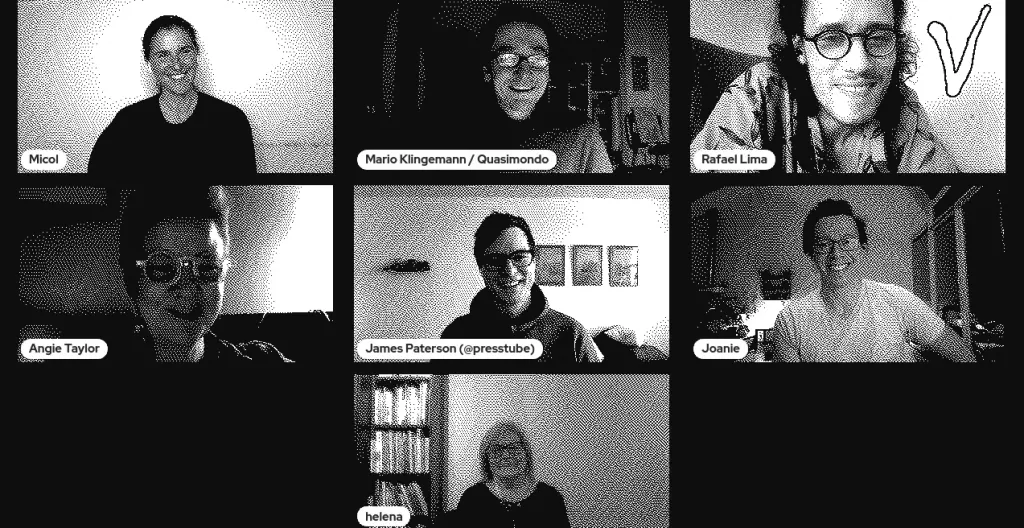Why Online Communities are the Future for Artists
Online art communities offer a sense of belonging that goes beyond simply being a mindless consumer. Find out why it's so important for you to build your community, and our top tips on getting started.


You wouldn’t be surprised to learn that we’re accustomed to sharing huge amounts of content online. From photos of our dogs to videos from our holidays, to product reviews, political opinions, and snippets of our personal work, everyone has something they enjoy sharing online.
In 2019 alone, 83% of global internet users regularly shared one form or another of this kind of information online on a monthly basis. You might think it’s the Gen Zers are responsible for setting the trend but in fact, this a truly cross-demographic activity, ranging from 70% of boomers to almost 90% of Gen Z and millennials.
Sure, having an online presence is nothing new. Businesses and individuals have, after all, have had websites for years — some from as early as the late ’90s and early 2000s. However, prior to to the rise of website builders, one needed to be highly skilled in HTML in order to create something remotely professional-looking, which has meant that the average artist or small business had no way of showcasing their works and products easily online. The rise of social media (Facebook launched in 2004, Instagram in 2010), meant that it suddenly became much easier to have an online presence.
As a result of all this rapidly changing technology, the old ways of brand management are becoming redundant.
If you’re an artist you might not consider yourself to be a brand. However, if you’re making, or trying to make, a living off of your art — we’ve got news for you: you are a brand. That’s why you need to think hard about how to best develop and grow your own digital community.
Aggressive marketing tactics and ‘hard sells’ are no longer in vogue. Instead, consumers want to feel connected to a brand and its messaging. They want to connect to the faces behind the brand. They want to be a part of that brand’s community. That’s exactly why having a thriving digital community is such an important way to engage with your fans and potential customers.
Simply sharing aesthetically pleasing content as a method of broadcasting yourself is no longer enough. Instead, content that has its community at its heart is the real winner.
The Online Community: A Quick Overview
Since the introduction of social media in the early 2000s, the definition and concept of what “community” means has rapidly evolved. Entire neighbourhoods now exist online (Next Door), local buying and selling groups have moved to Facebook, parents have apps designed specifically for them to meet other parents — the list is endless. The impact of these communities on a company’s brand is extremely significant. By building an online community, a company can discover what its target audience values and develop a meaningful way to deliver their services or products.
The history of social marketing can be broken down into two generations. The first generation had the brand as the heart of the discussion, with very little interaction with or between its fans. Think fancy billboards, flashy advertising, and well-crafted social media accounts that never responded to, let alone engaged with, their customers.
However, now that social media has become more developed, branding and communication involves much more interaction between fans. Some 81% of consumers still prefer to find information for a certain product or service on the business’ website, another 58% of consumers have joined a particular community, or bought a product, based on a friend’s social media recommendation. If you’re brand that finds itself stuck in the first generation of marketing, you need to immediately reconsider your strategy.
Building Your Own Online Community
As people begin to become overwhelmed by the sheer amount of content available to them online, they’re increasingly turning to meaningful online communities to feel like they’re a part of something bigger than just being a ‘consumer’.
An online community allows your fans and potential clients to exchange their thoughts, ideas, and to share their enthusiasm for your work. However, building an online community requires more than just occasionally posting on Instagram and creating a Facebook group. You need to get to know your target audience through questions such as who are they, how do they live, what motivates them, and what their expectations are from you and your work. You can start by looking at inspirational accounts online — there are plenty of artists that have built an impressive online presence — and seeing what they do that makes them popular.
One of the main things you need to be aware of when thinking about building your community is authenticity and relevance.
Remember, you need to have a USP, and you need to make sure you’re consistent in your communication. Your audience isn’t stupid — they’ll know when you’re being inauthentic. Treat your fans and potential clients like you would your close friends: with respect and genuine interest. Listen closely to what they have to say, and take constructive criticism into account. This approach doesn’t work instantly, but putting in the effort and time will undoubtedly pay off in the long term.
Join the .ART Community
Moving beyond your social media presence and the community that you’ll be building on Instagram, Twitter, Facebook, Pinterest or TikTok (or all of the above), you should also be thinking about your branding, and what your website represents. Beyond the obvious importance of the layout and aesthetic elements of your online portfolio, you shouldn’t underestimate the importance of your domain name. .art domains offers an instantly recognisable, concise, and art-specific domain that acts like your virtual business card. Plus, by joining the .art community, you’ll be a part of a global network of creatives, which in and of itself offers ample perks.






